new posts in all blogs
Viewing: Blog Posts Tagged with: Deborah Underwood, Most Recent at Top [Help]
Results 1 - 25 of 30
How to use this Page
You are viewing the most recent posts tagged with the words: Deborah Underwood in the JacketFlap blog reader. What is a tag? Think of a tag as a keyword or category label. Tags can both help you find posts on JacketFlap.com as well as provide an easy way for you to "remember" and classify posts for later recall. Try adding a tag yourself by clicking "Add a tag" below a post's header. Scroll down through the list of Recent Posts in the left column and click on a post title that sounds interesting. You can view all posts from a specific blog by clicking the Blog name in the right column, or you can click a 'More Posts from this Blog' link in any individual post.

By:
Betsy Bird,
on 11/6/2016
Blog:
A Fuse #8 Production
(
Login to Add to MyJacketFlap)
JacketFlap tags:
Ursula Vernon,
Leila Sales,
Christine Mari Inzer,
Alison DeCamp,
Funny Girl,
Adrianne Chalepah,
Akilah Hughes,
Delaney Yeager,
Mackenzie Yeager,
Shannon Hale,
Sophie Blackall,
Write Girl,
Rita Williams-Garcia,
Libba Bray,
Uncategorized,
Mitali Perkins,
Lisa Graff,
Cece Bell,
Lenore Look,
Charise Mericle Harper,
Carmen Agra Deedy,
Jenni Holm,
Raina Telgemeier,
Meghan McCarthy,
Deborah Underwood,
Lisa Brown,
Kelly DiPucchio,
Amy Ignatow,
Add a tag
Ladies and gentlemen . . . the moment I’ve been waiting for.
Wait! Wait! Background information first!
So for years I worked as a children’s librarian and I’d get girl after girl after girl coming up to my desk asking for funny books. I credit some of this to Diary of a Wimpy Kid. The boys and the girls loved that series and wanted more of the same. Sometimes they wanted it in a notebook novel format, like Kinney’s book. Sometimes they just wanted something hilarious, and they seriously didn’t care who wrote it. So I’d grab books for them and then it slowly began to dawn on me. Huh. For all that I could find some pretty fantastic and hilarious books out there for kids, where were the funny story collections written by women? Turns out, there weren’t any.
Until now.
I would like you to join me in applauding the following authors and author/illustrators . . . .
- Cece Bell
- Sophie Blackall
- Libba Bray
- Lisa Brown
- Adrianne Chalepah
- Alison DeCamp
- Carmen Agra Deedy
- Kelly DiPucchio
- Lisa Graff
- Shannon Hale
- Charise Mericle Harper
- Jenni Holm
- Akilah Hughes
- Amy Ignatow
- Christine Mari Inzer
- Lenore Look
- Meghan McCarthy
- Mitali Perkins
- Leila Sales
- Raina Telgemeier
- Deborah Underwood
- Ursula Vernon
- Rita Williams-Garcia
- Delaney Yeager
- and Mackenzie Yeager
Each one of these women has contributed to my new book Funny Girl: Funniest. Stories. EVER.
Behold! The cover by the aforementioned Charise Mericle Harper:

And here’s the full jacket in its entirety:

A portion of the proceeds of this book go to Write Girl, a Los Angeles-based creative writing and mentoring organization that matches girls with women writers who mentor them in creative writing.
When’s it out? May 9th, 2017! Feel free to pre-order it.
Oh! And while I’m thinking of it, there’s this other really fun thing that just started that I have to let you know about. As I may have mentioned before, my husband’s first book The Secrets of Story just came out recently and I could be prouder. He’s already put up a couple great videos alongside it (the latest is here and is about those little moments of humanity that make you like a character). But fun upon fun upon fun, he’s created a podcast with YA author and 90-Second Newbery Film Festival creator James Kennedy and it may well be my favorite thing of all time. I love it when James and Matt get together because they agree on NOTHING! And now they’ve a podcast together where they can extol the beauty of that nothing together. It’s huge fun for me, and it ends with a little feature where they mention a story idea they had that they decided wouldn’t work and give it away (as it were) to the masses for use. So if you like the process of writing or you just like banter, I’ve your new favorite podcast. The Secrets of Storytelling podcast is available through iTunes. Subscribe today!


By: Samantha McGinnis,
on 5/17/2016
Blog:
First Book
(
Login to Add to MyJacketFlap)
JacketFlap tags:
graphic novels,
Book Lists,
science,
Caldecott,
The Liberation of Gabriel King,
Loree Griffin Burns,
summer reads,
Citizen Scientists,
Mariko Tamaki,
Deborah Underwood,
Johanna Kerby,
A Balloon for Isabel,
graduation gifts,
This One Summer,
Inside First Book,
Our Recommendations,
K.L.Going,
Little Pink Pup,
Add a tag
The school year is coming to a close and it’s time to stock up for summer reading. We have five great books for you!
This month, our book list features a sweet story about an unconventional animal family, an adorable picture book that celebrates determination, a nonfiction guide to becoming a backyard scientist, and a book that teaches you how to stand up to their fears. For mature readers, the first-ever graphic novel to receive a Caldecott Honor will make for an engrossing read.
For Pre-K –K (Ages 3-6):
 Little Pink Pup by Johanna Kerby
Little Pink Pup by Johanna Kerby
Get ready to say “Awww!” every time you turn the page! The real-life photos of a tiny little pig being raised by dachshunds is a heart-warming story that promotes acceptance and reminds us that everyone deserves love.
For 1st and 2nd Grade (Ages 6-8):
 A Balloon for Isabel by Deborah Underwood
A Balloon for Isabel by Deborah Underwood
This adorable picture book is both a perfect read-aloud and an ideal graduation gift! It’s a joyful celebration of creativity, determination, and creative problem-solving. We can’t get enough of this one!
For 3rd & 4th grade (Ages 8-10):
 Citizen Scientists by Loree Griffin Burns
Citizen Scientists by Loree Griffin Burns
Anyone can be a scientist in this kid-friendly, non-fiction gem! Kids will learn how to observe, conduct research, collect data, and be part of four unique scientific discoveries that can happen anywhere — in a backyard, a field, or even a city park.
For 5thand 6th Grade (Ages 10-12):
 The Liberation of Gabriel King by K.L. Going
The Liberation of Gabriel King by K.L. Going
Warm, wonderful, and unforgettable, this is the terrific story of a boy whose best friend teaches him to stand up to his fears – from spiders to bullies and more. A perfect read for summer!
Grades 7 & up (Ages 13+):
 This One Summer by Mariko Tamaki
This One Summer by Mariko Tamaki
Both hopeful and heartbreaking, this beautiful book is the first graphic novel to be awarded a Caldecott Honor. Mature teens will find it captivating and will readily relate to its coming-of-age explorations of complex friendship and family relationships.
The post Monthly Book List: Our Favorite Books For May appeared first on First Book Blog.

Here Comes Valentine Cat
By Deborah Underwood; pictures by Claudia Rueda
Can a cranky cat have a change of heart towards an assumed canine enemy on Valentine’s Day?
You bet this Cat can.
If you’ve enjoyed Deborah Underwood’s New York Times Bestseller listing of cat conversations with a seemingly not to be moved feline, as in Here Comes Easter Cat, Here Comes the Tooth Fairy Cat, and Here Comes Santa Cat, then you are in for a sweet treat on this day for love.
Or, at the very least, in Cat’s case, a day of like!
Who of us does not appreciate a valentine sent from the one we’ve loved, liked or befriended?
But, what if the inference is made by young Cat that a valentine sent to a less than friend, following a volley of a tossed bone and ball, headed over Cat’s fence, is well deserved?
Cat’s crossed arms, picket signs with a dog in full growl mode, plus virulent valentines sent in response to the canine, are all signs of no relent mode on Cat’s part or heart.
Why things have even taken the shocking turn of rocket draft designs and a subtle crafting by Cat, that speaks of sending the canine skyward!
BUT, what if the soft-voiced and subtle offstage querier asks pointed questions of Cat, allowing the thrown bone and ball to be seen and felt in a whole new light? Might the missiles instead be proffers of friendship?
I love the dialectic that occurs between a soft spoken off stage friend and Cat. It’s always permeated not with judgment of Cat’s feelings, but rather, a sort of “Do you think you’ve looked at all the possible responses here?”
And the author sometimes even agrees with Cat’s frustration with the yowling of the neighboring dog, as in:
Wow. He is kind of loud, isn’t he?
Parents and young readers are in for a gentle primer here on the phrase “Never Assume” in the handling of what kids may take as the supposed motivation for actions they interpret as, well, less than friendly.
But then, on a bit of further reflection, bingo, it turns out to be quite another. And that goes for cat, canine or human behavior!
I love the listening ear of Cat’s confidante that serves alternately, and gently, as commiserator, sympathizer, yet also redirector of behaviors, as in:
Gee, Cat. Do you think
Dog was howling because
he’s…lonely?
Aw, Cat!
It’s not too late to be his friend!
Cat tries yet another neighborly Valentine, prompted by a sweet entreaty from dogdom. Cat’s valentine too, this time out, has less sass, and it reads:
Roses are red
Violets are blue
Dogs are annoying
What?!
except for you
Behavioral change is possible…in kids and cats. And with the ever cranky, but cute Cat to lead the way, Deborah Underwood and the spot on expressions for Cat, provided by Claudia Rueda, make the learning and laughing curve fun for young readers and parents.
Happy Valentine’s Day from Cat and Liz’s Book Snuggery!
By:
Sue Morris @ KidLitReviews,
on 2/10/2016
Blog:
Kid Lit Reviews
(
Login to Add to MyJacketFlap)
JacketFlap tags:
Children's Books,
friendship,
Picture Books,
Valentines Day,
Series,
Holiday Books,
Dial Books for Young Readers,
Deborah Underwood,
assumptions,
Penguin Random House,
Claudia Rueda,
5-Stars,
Here Comes Valentine Cat,
Add a tag
Here Comes Valentine Cat Series: Here Comes Cat Written by Deborah Underwood Illustrated by Claudia Rueda Dial Books for Young Readers 12/22/2015 978-0-525-42915-9 88 pages Ages 3—5 Junior Library Guild Selection “Cat is no fan of VALENTINE’S DAY, especially when it brings a new dog to the neighborhood. “Ouch. I’m sorry, Cat. …

By: James Preller,
on 1/20/2016
Blog:
James Preller's Blog
(
Login to Add to MyJacketFlap)
JacketFlap tags:
Deborah Underwood,
James Preller Interview,
Colin Jack,
Edgar's Second Word,
Edith Houghton,
Erin Murphy agent,
First Grade Dropout,
George and Martha Books,
Jane Yolan Butt In Chair,
Patrick and Ted,
The Kid from Diamond Street,
Unlike Other Monsters,
Interviews & Appreciations,
Alison Santos,
Audrey Glassman Vernick Interview,
Bob Shea Unicorn Thinks He's Pretty Great,
James Marshall,
Bob Shea,
Robert Neubecker,
Charlotte Zolotow Award,
Priscilla Burris,
Princeton Children's Book Festival,
Olugbemisola Rhuday Perkovich,
Geoffrey Hayes,
Matthew Cordell,
Tara Lazar,
Mac Barnett,
PiBoIdMo,
Add a tag
I’m not exactly sure when Audrey Glassman Vernick became a blip on my radar, but suddenly she was blipping everywhere. I felt like one of those guys in the mission control tower, trying to determine if this green blip was a “friendly” or an incoming missile. Ultimately, I decided that Audrey was a rising star.
I had the chance to meet Audrey personally, as opposed to through her books, at the 2015 Princeton Children’s Book Festival (thank you, Alison Santos!). We were at a backyard gathering, tired and happy after a long day. I bravely introduced myself, and we enjoyed a brief, easy conversation. I liked her immediately.
Anyway, I invited Audrey over to my swanky blog for today’s conversation. Here she comes now . . .

AGV: Why, it is swanky!
JP: I know, thanks. It’s the Picasso poster, isn’t it? I saved it from college.

But that’s the definition of class. It’s not just a hand or flowers. It’s both! And thanks for having me.
Glad to have you. About a month ago I read a bunch of your books. I was especially taken by Edgar’s Second Word, illustrated by Priscilla Burris. I even wrote to tell you how much I loved it, calling it “a small masterpiece.” Do you remember your reply?
I hope my first response was thank you. And I suspect my quick follow up was that you were one of approximately six people who read that book.

Yes, you were gracious. But you also mentioned that I was one of the few people to have actually read it. Which just goes to show that this is a crazy business. Your book has so much heart. It’s expertly constructed, like a well-built cabinet. We learn Edgar’s first word, “NO!” early on, so there’s a built-in tension: What will his second word be? That curiosity keeps us turning the pages. I was worried that the second word might be a letdown, but you totally delivered.
Thank you! Tension (and the building up thereof) is my very least developed writer skill, so extra thank you!
I interviewed James Marshall back in the early 90s, and he maintained that a strong ending for a book was essential. I’ll always remember what he told me: “The ending is what people remember. If the book fizzles at the end, they remember the whole thing as a fizzled book. It’s important to have a very satisfying ending for the reader. They’ve entered a world and now they are leaving it.” Wise words, and again, I think you nailed it with Edgar’s Second Word.
Let’s stop right here so I can faint. James Marshall!
I know, I was bragging to impress you. He’s one of my children’s book heroes. I can vividly remember our conversation. Heck, I can remember picking up the phone. James was friendly, funny, genuine, completely unpretentious.
George and Martha are the two main loves of my life. They are quoted with solemnity in the Vernick home.

Do you have a favorite line?
A truth about me (which does not go over well with kids at school visits): I am unable to pick a favorite anything except sports team (Yankees). Unable. So I could write some great lines here but then, minutes later, I’d erase and replace. (It is not easy being me.) Also, you sort of have to be looking at George and Martha along with reading their words to get the full picture. All that said, an oft-repeated line that comes to mind (you won’t even believe how lame this is) is:
“Boo!” cried George.
“Have mercy!” screamed Martha.
Nice, subtle. His humor is always natural, never seems forced. You never get the feeling that Marshall is trying too hard.
The blog I had and still kind of have was in large part an homage to those two, about literary friendships.
Oh, nice idea. There’s Frog and Toad, of course. Do you know the book Patrick and Ted by Geoffrey Hayes? It’s pretty perfect.
I do not. But I shall seek it out. Pronto!
I blogged an appreciation of it a while back. Let me see, it’s around here somewhere. Here you go, click on the link.

A scan from PATRICK AND TED by Geoffrey Hayes.
Back to your question.
Wait, there was actually a question?
The ending! You asked about the ending! It was the first, and only, thing I knew about the book when I started writing it. I received an email from a college friend whose young not-book-loving son (Edgar!) sat through his mother’s read-aloud of Is Your Buffalo Ready for Kindergarten? and, at the end, said, “Again.” I shared that with my wise agent, Erin Murphy, who said, “Well obviously you’re going to use that in a book, right?”
Right.
I don’t know if this happens to you, but when a book fails to sell, fails to reach an audience, I tend to slowly, inexorably begin to think of it as a failed book. And by extension, I begin to see myself as a failed writer. Intellectually, I know that’s wrong, but that’s my reality. So that’s why I’m dwelling on Edgar a little bit here. I want to be sure that you know it’s a great blipping book!
That’s a very George-to-Martha thing to say (maybe not the blipping part). Thank you! I have my dysfunctions when it comes to this publishing business. I suffer some jealousies. I focus on benchmarks I have not achieved. But I am pleased to say that in this one particular case, I still really love this book. Priscilla Burris’ illustrations are unspeakably sweet and perfect.

Yes, she did a terrific job. The right tone.
And the people who read it respond so well to it. It just didn’t find its people. That happens. It wasn’t the first time it happened to me. A nice side note is that it was named a highly commended title by the Charlotte Zolotow Award for Outstanding Writing in a Picture Book.
First Grade Dropout, illustrated by my pal Matthew Cordell, turns on a lovely mistake. A boy absent-mindedly calls his teacher, “Mommy.” Where did that idea come from?
Some years I take part in Tara Lazar’s Picture Book Idea Month (PiBoIdMo), in which you try to come up with a picture book idea each day of the month. One day I wrote “kid calls teacher mommy,” something I know happens in my sister’s second-grade classroom with some frequency. (I’ve since learned it happens in nearly every classroom.)
Yes, it rings true. That’s probably why it’s funny.
 It sat on that list for years because it wasn’t a story yet, just an incident. One day I decided to give it a try. In my experience, you sometimes have to start writing a picture book to find the story. And that voice just came out. It happened again a few months ago, when I was looking for a follow-up to that book. I brainstormed ideas with my editor, but while we had fun and shared lots of embarrassing elementary-school memories, we didn’t hit upon anything usable for a book. Once I started writing, though, I found the idea for Second Grade Holdout, which is coming out next year (because Matt is F-A-S-T as well as fantastic).
It sat on that list for years because it wasn’t a story yet, just an incident. One day I decided to give it a try. In my experience, you sometimes have to start writing a picture book to find the story. And that voice just came out. It happened again a few months ago, when I was looking for a follow-up to that book. I brainstormed ideas with my editor, but while we had fun and shared lots of embarrassing elementary-school memories, we didn’t hit upon anything usable for a book. Once I started writing, though, I found the idea for Second Grade Holdout, which is coming out next year (because Matt is F-A-S-T as well as fantastic).
I am crazy about Matt. I once slept in his guest room. He even drove me to the airport. Strangely, Matt insisted on dropping me off sixteen hours early, which was confusing.
You are wise to be crazy about Matt. He’s kind and funny and so talented. Immensely likable.
Well, let’s not get carried away, Audrey. He’s okay. But I’ll be hog-tied if I let Cordell hijack this interview! So, yes, you discovered the idea for Holdout . . . through the act of writing. Jane Yolen’s famous “butt in chair” advice. How do you actually get work done, Audrey? Do you have a time clock where you punch in each morning? Or do you wait for inspiration?
Somewhere in the middle. I am not disciplined. With picture books, I write when inspiration strikes, but with novels I need to force myself to sit and write. And I have to come up with sad little bargains to keep myself in the chair, writing.
Such as?
I’m only allowed to sit in the comfy chair with the heated blanket when I’m working on a novel. And once I’m there, it’s still a whole bargaining thing. If you finish the chapter, you can shower. Or eat breakfast. Or walk the dog.
Oh, that poor dog. Getting back to James Marshall, you share a great trait with him. You’re funny. And even better, you are able to write funny, which is a distinct and rare talent. There’s never enough of that in children’s books. Children’s publishing went through a biblio-theraputic period where every picture book had to be about something important. Laughter lagged behind.
I nearly fainted from the first sentence here.
And I agree that there’s never enough funny. But there are so many more now than there used to be. The books that were considered funny when I was a kid and, for the most part, when my kids were little, were more amusing than genuinely funny. Lots of modern picture books are flat-out hilarious. It’s a really fun time to be writing them.
Can you name a few of your favorites?
See previous explanation of ever-changing favorites. That said, I believe the Pigeon books kind of burst the door open to a new kind of funny. Bob Shea’s books often crack me up and I have serious title-envy about his Unicorn Thinks He’s Pretty Great. Like debilitating jealousy.

Deborah Underwood’s Cat is a brilliant new character.
I really liked Ryan T. Higgins’ Mother Bruce and Julia Sarcone-Roach’s The Bear Ate Your Sandwich.
Good to know. I understand that 2016 is going to be a big year for you.
I have four books coming out.
Wow. Girl is on fire. You realize I kind of hate you now? A little.
I can both understand and accept that and will just quickly add that it’s possible I have four books coming out in six months -— the pub date for the last release of the year has not been set.
Shoot me now. I mean: I’m sooooo happy for you!!!!!
Aww!
I’m curious, how do you do it? I find that writing picture books can be so difficult. I’ve been seriously trying for the past year and everything comes out half-baked, half-finished, half-awful. There are times it feels like throwing darts in a darkened room. It’s so easy to go down the wrong path. I wonder if you can talk about your process a little bit. Do you begin with a character?
I write both fiction and nonfiction picture books, and for the nonfiction ones, I look for a subject, get obsessed, research and write.
Do you first clear the topic with an editor?
I float it more than clear it. Or maybe those are the same. I am not writing with a contract, to be clear.
And for your fiction titles?
Just about every one has been different. Sometimes, the title comes first and leads the way to the story. Teach Your Buffalo to Play Drums was the first of those for me. Once a whole first page came to me, unbidden:
“Zander was a monster. This wasn’t strange as his father was a monster. His mother too. Oddly, his sister was a fairy. And his dog was a skunk.”
That last sentence just killed me. (And then, as with many lines I love, I had to fight to keep it.) That’s from Unlike Other Monsters, coming out in June.

-
And his dog was a skunk. That’s a funny line. Comedy gold! Sometimes with the right sentence, even just a few words, or the right rhythm, a door seems to open. You can suddenly find your way in.
I don’t think any of my picture books has started with a character, which I didn’t realize until you asked. With novels, it’s always character. But it’s usually title/concept or incident that gets me started with picture books.
Getting back to what you said about going down the wrong path -— to me, that’s what is so great about picture books! If you do it in a picture book, you erase the last 100 words and go back to the fork. With a novel, hacking out 50 pages feels like pulling out a minor organ.
I maybe once cried when cutting 10,000 words from my book, Six Innings.
The first novel I wrote, Water Balloon, I wrote these extra 50 pages before the story really got going. I so wanted credit for those pages.
Even so, picture books have to be “just so.” You know? I feel like there’s more forgiveness in a longer work. More room to wander. With a picture book, basically 30 pages, there’s not a lot of space to get lost. That’s why I’ve concentrated on longer works, because I felt it gave me more control over my (and the book’s) fate.
I adore picture books. I love writing them. I love the very fact of them. I enjoy every step of picture book writing and revising. But getting a first draft of a novel done -— the avoidance I have to fight is embarrassing. I’m in that place now. At least ninety percent through a novel I’ve been working on for years. I am looking forward to being done but not to what I have to do to be done.
That’s how I feel about exercise.
Me too.
I could be wrong here, but it seems there are not many folks that are exclusively writers who have built a reputation in picture books. There’s Tony Johnston, Eve Bunting, Ruth Krauss, Mem Fox, Charlotte Zolotow. It’s not a long list. Mac Barnett, of course, is doing great work now. Though it was only last week when I first realized that he wrote Sam and Dave Dig a Hole. I had previously thought of it strictly as a Jon Klassen title.
Well, crap. I guess I knew that but I never knew it in words. Thanks.
You’re welcome! I like that you’re a big baseball fan. Where’d that come from?
When kids ask this at school visits I always give the super-articulate answer that goes something like, “It’s hard to say why you like what you like. For example, I love pizza. Why? Because it tastes good.” Note to self: Work on that response.

I was on a panel recently with a bunch of seasoned writers –- Todd Strasser, David Levithan, others –- and they all had such great, pithy answers to audience questions. I was like, “Damn, I have to raise my game.” The whole staring and stammering thing won’t cut it.
I don’t think anyone will ever say that about me. You know what impressed me about that Vernick? Pithy answers.
Pithy can feel too slick on some folks. I like your stammering authenticity.
My love of baseball -— sunny days (I will always take a day game over a night game); the fact that it’s a sport without a clock, with a lot of time for a mind to wander, to wonder, to draw connections; and it’s a sport with an immensely rich history (albeit one with very few women in it).
I associate baseball with my mom, who is still a huge fan at age 89. She taught me how to throw, how to catch. So there’s a lot of transference there: by loving baseball, I’m expressing love for my mother. Also, I loved playing, and still do. Now that I’m finished coaching (had a 15u travel team last season), I’ll probably return to a Senior Men’s Hardball team next spring. Read that as: Old guys clutching their hamstrings. We’re all still boys at heart. Did you ever get to play?

First I have to say I just love that, your connection to your mom there. Organized sports for girls didn’t exist when I was younger. I played softball at camp and was sometimes good. In my neighborhood, it was mostly punchball in the street. A neighborhood of girls. Seriously, I think there was only one boy and we were terrified of him because he once threw a firecracker at my sister.
He was probably terrified, too. Don’t we all throw firecrackers when we’re afraid? I know you are a Jersey Girl, and a mother, but outside of that, I don’t know much about your background.
Okay, first of all, no. I grew up in New York City -— in Queens. I’ve lived in NJ 19 years. Wow. That’s a long time. But I definitely do not identify as Jersey Girl. Strike that from the record!
Done. Both my parents were from Queens, so I like this better, anyway.
I live near the ocean. When I lived on eastern Long Island —- my home before this one, and Boston before that -— my house was a block from the Long Island Sound. I hope to always live near a big body of water. My present and future dogs probably hope so too.
Have you written a dog-and-ocean book yet?
I cannot sell a dog book. It kills me.
I hear hedgehogs are trending. Or was that five years ago? It’s hard to keep up.
I wrote literary short fiction for adults before writing for kids. It’s a very good way to learn to accept rejection.
So how did you get into children’s books?
It’s a sad story. You’ve been warned.
When I was in my early twenties, my mother was taking a children’s writing class at the New School in NYC and she sent the first novel she wrote to one publisher (Dutton) and it was accepted. She died two months later, a pedestrian on the sidewalk, hit by a car around the block from my childhood home.
 My family was reeling for years. And in that time, we had to work with my mother’s very patient editor. My mother hadn’t even received her editorial letter at the time of her death, so all the revision fell to us. As you might imagine, we didn’t want to change a single one of her words. So that was my first step, as the literary executor of her estate. (The book, The Morning Glory War, was published in 1990 and received a really nice review in the Sunday Times.)
My family was reeling for years. And in that time, we had to work with my mother’s very patient editor. My mother hadn’t even received her editorial letter at the time of her death, so all the revision fell to us. As you might imagine, we didn’t want to change a single one of her words. So that was my first step, as the literary executor of her estate. (The book, The Morning Glory War, was published in 1990 and received a really nice review in the Sunday Times.)
Wow. You must have taken a deep breath before typing that out. Like, “Okay, here goes, you asked.” I know that feeling, Audrey, since my oldest is a two-time cancer survivor. I’ve lost two brothers. These are not happy stories to tell at parties. Oftentimes, it’s easier not to get into it. And you’re right, it is sad, but it’s also an incredible story.
Yeah, as I wrote that out, I could see clearly that my family led me here.
Years later, I fell in love with the art of an outsider artist named Tim Brown, showed his art to one of my sisters, and she said that it belonged in a children’s book. Together, we wrote that book.
Which book is that?
Bark and Tim: A True Story of Friendship.
Hey, um, Audrey, this is nice and everything but . . . are you going to leave? I mean, ever? Or am I supposed to feed you now? I guess I have a pull-out couch . . .
Yeah, maybe tomorrow I’ll start pulling my stuff together. I could walk your dog. Do you have a dog?
Daisy. And two cats. And three kids. And four . . . well, it all stops at four. I don’t have four of anything.
I’m sure you have four readers of your blog!
Oh, dozens more. Dozens! We’re basically talking to ourselves here. It’s like the Cone of Silence in “Get Smart.” But before you go, is there anything you can share about your upcoming books?
Okay, since you asked:
The Kid from Diamond Street: The Extraordinary Story of Baseball Legend Edith Houghton, illustrated by Steven Salerno, nonfiction about a Philadelphia girl playing professional baseball from age 10.

The real Edith Houghton.
I Won A What?, illustrated by Robert Neubecker, about a boy who hopes to win a goldfish and ends up with something a wee bit bigger. And better.
Unlike Other Monsters, illustrated by Colin Jack, with the opening page mentioned above. And a novel, Two Naomis, written with my dear friend Olugbemisola Rhuday Perkovich.

How did you co-author a book? It’s seems difficult, fraught with peril. How did you handle it?
I have co-authored four books. Two Naomis was the first novel. We each wrote from the point of view of our own Naomi. So my chapters were the even-numbered ones — individual writing of separate chapters. When I co-wrote picture books, first with my sister and most recently with Liz Garton Scanlon, we just back-and-forthed a lot. Both experiences were really freeing and so much easier than doing it alone.
So what’s for dinner?
Get out!
But before you go, by way of thank you, please accept this set of steak knives as a parting gift. I wish you all the luck in the world, Audrey. Keep up the great work.

By:
Sue Morris @ KidLitReviews,
on 12/7/2015
Blog:
Kid Lit Reviews
(
Login to Add to MyJacketFlap)
JacketFlap tags:
Children's Books,
holidays,
Picture Book,
cats,
humor,
Favorites,
Series,
Christmas books,
Dial Books for Young Readers,
Holiday Book,
Deborah Underwood,
5stars,
Library Donated Books,
Claudia Rueda,
Here Comes Santa Cat,
Penguin Random House Company,
Add a tag
$50 Gift Certificate Holiday Giveaway Enter here: Mudpuppy Holiday Giveaway . Here Comes Santa Cat Series: Here Comes Cat Written by Deborah Underwood Illustrations by Claudia Rueda Dial Books for Young Readers 10/21/2014 978-0-8037-4100-3 88 pages Age 3—5 . “HO, HO . . . WHO? CAT! NOT AGAIN. “The holidays are around …
By:
Bianca Schulze,
on 12/1/2015
Blog:
The Children's Book Review
(
Login to Add to MyJacketFlap)
JacketFlap tags:
Deborah Underwood,
Disney-Hyperion,
Christian Trimmer,
Schwartz & Wade,
Benji Davies,
Rob Sanders,
Charlesbridge books,
Teens: Young Adults,
Best Books for Kids,
Jory John,
David Teague,
Best Kids Stories,
Kristen Remenar,
Claudia Rueda,
Popular Kids Stories,
Best New Kids Books,
Roman Muradov,
Poppy Books,
Guojing,
Eric Lindstrom,
Jessica Haight,
Melissa van der Paardt,
Pablo Hidalgo,
Phil Szostak,
Rick Carter,
Stephanie Robinson,
Ages 0-3,
Ages 4-8,
Ages 9-12,
Book Lists,
featured,
Atheneum Books for Young Readers,
Jim Murphy,
Kate Messner,
DK Children,
Random House Books for Young Readers,
Debbie Ridpath Ohi,
Delacorte Books for Young Readers,
Clarion Books,
Antoinette Portis,
Matt Faulkner,
Scholastic Press,
Sara Gillingham,
Abrams Books,
Dial books,
Add a tag
After taking a look at our selection of hot new releases and popular kids' books ... it's more than likely we're suckers for picture books about love, kindness, and compassion.
By:
Bianca Schulze,
on 5/1/2015
Blog:
The Children's Book Review
(
Login to Add to MyJacketFlap)
JacketFlap tags:
Best Kids Stories,
Sara O'Leary,
Best New Kids Books,
Graphix Books,
Dutton Books for Young Readers,
Jihyeon Lee,
The Baby-Sitters Club Series,
Viking Books for Young Readers,
Ages 0-3,
Ages 4-8,
Ages 9-12,
Book Lists,
Chronicle Books,
Gift Books,
Sarah Dessen,
Cynthia Lord,
Kate Messner,
John Grisham,
Ann M. Martin,
Meg Hunt,
Tom Lichtenheld,
Simon & Schuster Books for Young Readers,
Tundra Books,
Mark Siegel,
Scholastic Press,
Beach Lane Books,
Liz Garton Scanlon,
Julie Morstad,
Raina Telgemeier,
Deborah Underwood,
Theodore Boone,
Stuart Gibbs,
Beth Ferry,
Teens: Young Adults,
Add a tag
Mayday, Mayday, Mayday! The Children's Book Review (call sign TCBR) is declaring a reading emergency. The weather is clear and suitable for reading outside.
 You know that feeling that you’ve missed something? Well, I had that feeling last week when I pulled out the titles for my class’s mock Caldecott. I blithely grabbed Bad Bye, Good Bye and thought, “Uh-oh. I never wrote about this one, did I?” In true Robin Smith fashion (ask any of my editors what a procrastinator I am), here I am, just under the wire, to chat about this fine book.
You know that feeling that you’ve missed something? Well, I had that feeling last week when I pulled out the titles for my class’s mock Caldecott. I blithely grabbed Bad Bye, Good Bye and thought, “Uh-oh. I never wrote about this one, did I?” In true Robin Smith fashion (ask any of my editors what a procrastinator I am), here I am, just under the wire, to chat about this fine book.
I first read about this book months and months ago when Jules Danielson interviewed the illustrator, Jonathan Bean, here on her blog. Go and read the link, because his explanation of color separation (old school!) is interesting and clear. In the comments are technical questions about brayers and Prismacolors and friskets. I got lost there for a little bit.
Here’s the skinny:
- I love the emotional intensity of the illustrations — even the endpapers start with a very dark blue-black and end with a sunny yellow. The title page shows one angry boy glaring at the moving man. Even his dog is furious. The stripes on the boy’s shirt are parallel with the spine of the dog, leaving no question about how these two are feeling about their family’s move to a new town and new house. The background shows the movers moving at full speed, rendered only in pencil. The title is placed on the page a little wonky, implying movement. The page turn shows the boy redder even than before—all the way to his scarlet scalp! We all know that feeling.
- That anger has to abate, of course, and the long nap in the car and dip in the motel pool seem to be a turning point for everyone. By the time the family arrives in the new town, after mom and dad take turns behind the wheel, everyone seems ready for the new house. Even the movers seem to have happy energy.
- The illustrations deftly extend the spare, rhyming couplets. I especially appreciate the “Road games /We’re here” page. It’s a brilliant interpretation of the alphabet game we always played in the car to pass the time. Bean draws a variety of signs with just about every letter of the alphabet shown, including q in antique. Another spread (“New house/New wall/New room/New wall”) shows that creepy feeling when you walk into an empty house or apartment for the first time. Everything is still in boxes and the illustrations are layered with the details that add to that strange feeling: the lone light hanging from the ceiling in the hall, other people’s wallpaper, stacks of chairs and boxes marked “pots” and “sheets.” Seeing the boy cautiously opening all the doors, one at a time, brings me right back to all my Army brat moves.
- The happy resolution is just right, too: this is a book for the very young reader, and it needs to be comforting. It is — right down to the fireflies, a neighbor boy who will clearly be a friend, and a climbing tree.
There is a lot going on in these illustrations, inviting the reader to slow down and explore every inch of the page. That also allows committee members lots to talk about: artistic technique, satisfying page-turns, and emotional punch. It would also make a dandy book for new readers. Geisel and Caldecott committees, pay attention to this one!

The post Bad Bye, Good Bye appeared first on The Horn Book.
Here Comes Santa Cat
By Deborah Underwood; pictures by Claudia Rueda
I just found the perfect picture book for the weekly story time for 3, 4 and 5 year olds who may be a tad anxious this time of year. Their reason? An internal examination of conscience may have put some of them, from time to time, on Santa’s proverbial “naughty list!”
Enter Deborah Underwood’s “Here Comes Santa Cat” with pictures by Claudia Rueda who has the gift of portraying frustration, glee, chagrin, doubt and pure joy on the face of a cat. It’s the run up to Christmas and the reader of this picture book gets to act out the part of a gentle inquisitor, asking a Santa clad cat some mildly probing questions such as:
Question: Why are you dressed like Santa?”
Drawn Response: So you can give yourself a gift?
Seems Cat figures it is a pretty safe bet that he is NOT on the “nice” list which leaves a very ungratifying conclusion. Yes, it’s the “naughty list” for Cat and the solution is perhaps to gift himself because he thinks Santa won’t!
The gentle inquisitor, through a series of give-and-take queries, involves Cat in a education on what it means to BE Santa and Cat’s facial responses are priceless. Climbing down sooty chimneys and jet pack driven rides that end up in tumbles from the sky are not Cat’s idea of Santa scintillation.
The questioner softly tells Cat that Santa does not GET presents, he GIVES them and he suggests Cat just try being NICE.
A worried Cat, carrying a December 24th sign is assured that it’s not too late. He tries caroling or YOWLING, gifting kids with…FISH, decorating the town square tree – all end in disaster. Yet Cat is GIFTED with two cans of fancy cat food by the gentle cat questioner.
This is where the rubber hits the road in Cat’s Santa charade as a poor kitten wanders by, crying out.
“Any ideas?” asks the reader.
The frustrated tug-of-war “what to do” look on Cat’s face is a true artistic endeavor. He KNOWS what he has to do, but covers his eyes as he extends a paw with a can of cat food. Ah Cat! We knew you had it in you! And so does Santa as Cat is gifted by Santa himself with… But then again Christmas is supposed to be a time of surprises, no?
Please read this endearing story to a young reader this holiday season. It never sidesteps the difficulty in being a normal kid, yet exults with Santa Cat at the lesson he learns that it’s always better to give than to….But you knew that, right?
By:
Bianca Schulze,
on 12/1/2014
Blog:
The Children's Book Review
(
Login to Add to MyJacketFlap)
JacketFlap tags:
Pascal Campion,
Seasonal: Holiday Books,
Rudolph Red Nosed Reindeer,
Best Kids Stories,
Daphne Benedis-Grab,
Claudia Rueda,
Paul Czajak,
Wendy Grieb,
Putnam Juvenile books,
Keith Andrew Finch,
Lisa Ann Marsoli,
Bloomsbury USA Books,
Christmas Tree Books,
Holiday Gift Guide Kids Books,
Reindeer Books,
Scarletta Kids Books,
Ages 0-3,
Ages 4-8,
Ages 9-12,
Christmas,
Book Lists,
Gift Books,
featured,
Alison Mcghee,
Stephen Krensky,
Jan Brett,
Silver Dolphin Books,
Diane Muldrow,
Peter Reynolds,
Dial books,
Deborah Underwood,
Add a tag
In the spirit of the most wonderful time of the year, we've put together a list of the best new kids' Christmas books that capture the holiday magic. We know you'll love our Christmas Books booklist!

By:
Tara Lazar,
on 11/17/2014
Blog:
Tara Lazar
(
Login to Add to MyJacketFlap)
JacketFlap tags:
Picture Books,
Deborah Underwood,
The Quiet Book,
The Loud Book,
Part-Time Princess,
Sugar Plum Ballerina,
PiBoIdMo 2014,
Here Comes Santa Cat,
Here Comes the Easter Cat,
Add a tag
 by Deborah Underwood
by Deborah Underwood
Congratulations, PiBoIdMo-ers! You’re more than halfway home! (56.6666% home, but who’s counting?)
At this point in the game, you may be a little stuck. Believe me, I know the feeling. When I’m devoid of ideas, sometimes remembering the origins of an existing manuscript yields clues about how I might forge ahead.
So, in hopes that it might help you, let me share the genesis of Here Comes the Easter Cat, illustrated by Claudia Rueda. The book resulted from three things that happened in June of 2011:
1) I was floundering around looking for inspiration, so I wrote to a friend, the founder of an animal museum. I asked if there was a kids’ book she saw a need for, something that might be helpful to her in her work. She mentioned that a woman she knew had trouble finding suitable Easter books for her vegan book review site. I didn’t find the idea of writing an Easter book particularly compelling, so I thanked her and promptly forgot about her suggestion. (Or so I thought!)
2) A few weeks later, I had a weirdly illustrator-centric week. I had coffee with one visiting illustrator, coffee another day with two others, and lunch with a local illustrator friend.
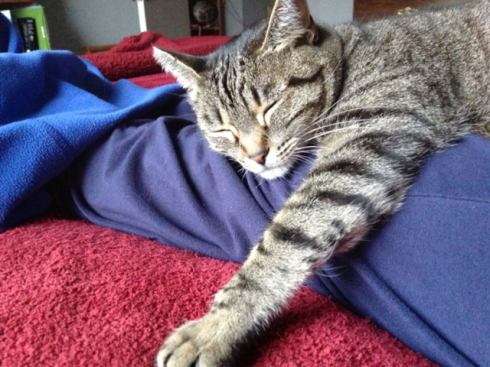
3) Several days after that, I was sitting on my bed, still trying to come up with a viable idea. My cat Bella was sprawled in front of me, so I idly doodled a cat. The cat looked grumpy. I asked why, and, to my surprise, the cat held up a sign with the Easter Bunny on it. Intrigued, I continued to ask the cat questions, and Here Comes the Easter Cat took shape.



Why did I decide to draw? I’m not sure, but I’ll bet it was because I’d just talked with all those illustrators.
And why did the Easter Bunny show up on Cat’s sign? Undoubtedly because my friend had mentioned that Easter book a few weeks earlier.
So the book idea came about because:
- I actively sought input from someone outside my usual circle.
- I took off my pajamas—horrors!—and got out into the world, and in doing so, learned more about how illustrators work.
- I gave myself the space to think (sitting on my bed, trying to be receptive) and to play (doodling).
So I was active, and I was passive. I soaked up information from others, and I experimented with something outside my area of expertise. If any of those elements hadn’t been present, I suspect there would be no Cat.


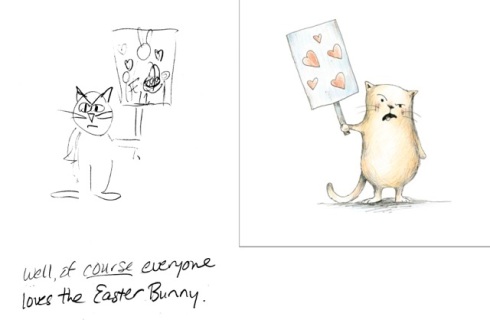
In particular, the drawing component was critical. So I encourage you to play around with doodling or sketching, even if you think you’re not an artist. Here Comes Easter Cat came out earlier this year, Here Comes Santa Cat was just released, and two more Cat books are in the queue. I’m very, very glad I did that first Cat sketch.
One more thing: when I began Easter Cat, I was not thinking of the market. I was definitely not saying, “What the world really needs is an 80-page picture book!” or “I’ll bet my editor is dying to see a stack of sketches by someone who can’t draw!”
Rather, I was having a conversation with Cat for the best of reasons: it amused me. It made me laugh. And what I loved turned out to be what my agent and my editor loved, too.
I am embarrassed to say that I need to remind myself of this over and over. It’s so easy to get caught up in questions like “What do editors want?” and “What can I sell?”
When really, the critical question is, “What do I love?”
So write with your heart. And draw! And if one of your sketches starts talking to you? You should probably pay attention. Best of luck!

Deborah Underwood grew up in Walla Walla, Washington. When she was little, she wanted to be an astronomer. Then she wanted to be a singer. Then she wanted to be a writer. Today her jobs are writing and singing. Two out of three’s not bad! (Okay, she also wanted to work in a piano factory and paste the labels on new pianos, but let’s just ignore that one.)
She’s the author of THE QUIET BOOK, THE LOUD BOOK, PART-TIME PRINCESS, the SUGAR PLUM BALLERINAS series (with Whoopi Goldberg), and, of course THE CAT books, among others.
When she’s not writing, you might find her singing in a chamber choir, playing a ukulele (very badly), walking around in Golden Gate Park, baking vegan cookies, or petting any dogs, cats, pigs, or turkeys that happen to be nearby.
You can connect with her at DeborahUnderwoodBooks.com or on Twitter @underwoodwriter.

Deborah is giving away one copy of EASTER CAT and one copy of SANTA CAT!


These prizes will be given away at the conclusion of PiBoIdMo. You are eligible for these prizes if:
- You have registered for PiBoIdMo.
- You have commented ONCE ONLY on today’s post.
- You have completed the PiBoIdMo challenge. (You will have to sign the PiBoIdMo Pledge at the end of the event.)
Good luck, everyone!



By: JOANNA MARPLE,
on 10/24/2014
Blog:
Miss Marple's Musings
(
Login to Add to MyJacketFlap)
JacketFlap tags:
HERE COMES SANTA CAT,
cats,
Christmas,
picture book review,
teaching resources,
Deborah Underwood,
being nice,
Perfect Picture Book Friday,
Claudia Rueda,
Add a tag
Title: Here Comes Santa Cat Written by: Deborah Underwood Illustrated by: Claudia Rueda Published by: Dial Books for Young Readers, Oct 21st, 2014 Suitable for ages: 3-7 Themes: cats, being nice, Christmas, Santa Fiction, small format, 80 pages Opening Lines: … Continue reading →

By:
Betsy Bird,
on 8/29/2014
Blog:
A Fuse #8 Production
(
Login to Add to MyJacketFlap)
JacketFlap tags:
Reviews,
Best Books,
picture book reviews,
Houghton Mifflin Harcourt,
Deborah Underwood,
Best Books of 2014,
Reviews 2014,
2015 Caldecott contender,
2015 Geisel contender,
Add a tag
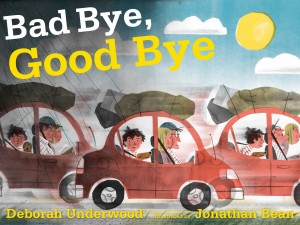 Bad Bye, Good Bye
Bad Bye, Good Bye
By Deborah Underwood
Houghton Mifflin Harcourt
$16.99
ISBN: 978-0-547-92852-4
Ages 3-7
On shelves now
As a mother who recently spent the better part of twenty hours in a car with a three-year-old and a three-month-old baby, I feel a special kinship with parents who have also engaged in the ultimate endurance sport: travel with children. If you feel no particular sympathy for those engaged in this activity that is because you have not experienced it firsthand yourself. But even when my daughter was projectile vomiting regularly and even when the breast pump tipped to one side spilling milk all over my pants and EVEN WHEN I found myself wedged in the backseat between two car seats trying to change my son’s diaper on my lap while parked, I could still feel grateful because at least it was just a vacation. It wasn’t like we were moving to a new town or anything. Because if I’d had to deal with the abject misery of my three-year-old on top of the vomit/milk/diapers I don’t know how my sanity would have remained intact. And yet, other parents do it all the time. Every day someone somewhere packs up all their worldly possessions, their pets, and their miserable offspring and heads for a whole new life. It’s daunting. You can’t help but admire their guts. And boy, you’d sure like to hand them a book that they could use to show their kids that as scary as a move like that can be, ultimately it’s going to be okay. Enter a book so sparse and spare you’d never believe it capable of the depth of feeling within its pages. Deborah Underwood lends her prodigious talents to Bad Bye, Good Bye while artist Jonathan Bean fills in the gaps. The effect is a book where every syllable is imbued with meaning, yet is as much a beautiful object as it is a useful too.
“Bad day, Bad box” says the book. On the page, a boy wrestles with a moving man for possession of a cardboard box, doomed to be loaded into the nearby moving van. The boy, we see, is in no way happy about this move. He clearly likes his home and his best friend, who has come with her mother to bid him goodbye. On the road he and his little sister pitch seven different kinds of catfits before sinking into a kind of resigned malaise. Time heals all wounds, though, and with the help of a motel swimming pool, diners, and multiple naps, they arrive in their new town in the early evening. As the family and movers pile boxes and other things into the new house, the boy meets another kid who just happens to live next door. Together they collect lightning bugs and star gaze until that “bad bye” at the beginning of the book morphs into a far more comfortable “good bye” when the new friends bid each other goodnight.
This isn’t Underwood’s first time at the rodeo. The art of the restrained use of language is sort of her bread and butter. Anyone who has seen her work her magic in The Quiet Book is aware that she says loads with very little. I sincerely hope someone out there has been bugging her to write an easy book for kids. The talent of synthesizing a story down to its most essential parts is a rare one. In this book there is a total of 57 words (or so). These usually appear in two word pairs and by some extraordinary bit of planning they also rhyme. We begin with all “bads”. It goes “Bad day, Bad box / Bad mop, Bad blocks / Bad truck, Bad guy, Bad wave, Bad bye.” The book then slips into neutral terms as the initial misery wears off. Then, as we near the end the “goods” come out. “Good tree, Good sky / Good friend, Good bye.” Such a nice transition. You could argue that it’s pretty swift considering the depths of misery on display in the early pages, and that’s not too far off, but kids are also pretty resilient. Besides, motel swimming pools do indeed go a long way towards modifying behavior.
Jonathan Bean’s one to watch. Always has been. From the moment he was doing Wendy Orr’s Mokie & Bik books to the nativity animalia title “One Starry Night” to all those other books in his roster, he proved himself a noteworthy artist. Watching his work come out you have the distinct sense that this is the calm before the storm. The last minute before he wins some big award and starts fielding offers from the biggest names in the biz. In this book I wouldn’t necessarily have said the art was by Bean had I not seen his name spelled out on the cover. It’s a slightly different style for him. Not just pencil and watercolors anymore. A style, in fact, that allows him to try and catch a bit of Americana in the story’s pages. When Underwood writes something like “Big hair, White deer” it’s Bean’s prerogative to determine what that means exactly. His solution to that, as well as other sections, is layering. Time and landscapes are layered on top of one another. America, from diners and speed limit signs to windmills and weathervanes, display scenes familiar to traveling families. A great artist gives weight and meaning to the familiar. Jonathan Bean is a great artist.
Now the cover of this book is also well worth noting. I don’t say that about a lot of picture books either. Generally speaking a picture book’s cover advertises the book to the best of its ability but only occasionally warrants close examination. Jonathan Bean, however, isn’t afraid to convey pertinent information through his cover. In fact, if you look at it closely you’ll see that he’s managed to encapsulate the entire story from one flap to another. Begin at the end of the book. Open it up. If you look at the inside back flap the very first thing you’ll see underneath the information about the author and the illustrator is the image of the boy in the story straining against his seatbelt, his face a grimace of pure unadulterated rage. Now follow the jacket to the back cover of the book and you see the boy crying in one shot and then looking miserably back in another. The weather is alternating between a starry night sky and a windy rainy day. Move onto the front cover and the rain is still there but soon it turns to clear skies and the boy’s attitude morphs into something distinctly more pleasant. In fact, by the time you open the book to the front flap he’s lifting his hands in a happy cheer. The attitude adjustment could not be more stark and it was done entirely in the span of a single book jacket. Not the kind of thing everyone would notice, and remarkable for that fact alone.
People are always talking about “the great American novel”, as if that’s an attainable ideal. We don’t ever hear anyone talk about “the great American picture book”. I don’t know that Bad Bye, Good Bye would necessarily fit the bill anyway. This is more the picture book equivalent of On the Road than To Kill a Mockingbird, after all. It’s a road trip book, albeit a safe and familiar one. For children facing the frightening prospect of the unknown (and let’s face it – adults hardly do much better) it’s good to have a book that can offer a bit of comfort. A reassurance that no matter how things change, good can follow bad just as day follows night. They are not alone in this uprooting. Somewhere out there, in another car, with another family, there might be a kid just as miserable as they are and for the exact same reason. And like all humans this knowledge ends up being comforting and necessary. Therefore give all your love to Bad Bye, Good Bye. It has necessary comfort to spare.
On shelves now.
Like This? Then Try:
- A New Room for William by Sally Grindley
- Herman’s Letter by Tom Percival
- The Good-Pie Party by Liz Garton Scanlon
- Alexander, Who Is Not (Do You Hear Me? I Mean It!) Going to Move by Judith Viorst
- Tim’s Big Move by Anke Wagner
Misc: And I interviewed Ms. Underwood about the book here.

 |
Arthur Levine and
Deborah Underwood
started off with a song. |
Arthur Levine is something of a legend in the children's publishing industry. He's published many beloved books, including Philip Pullman's His Dark Materials trilogy, J.K. Rowling's Harry Potter series, and the comic novels of Lisa Yee.
He founded his own imprint at Scholastic,
Arthur A. Levine Books, in 1997. The imprint publishes everything from picture books through young adult novels. His authors and illustrators include Shaun Tan, Dan Santat, Markus Zusak, Francisco Stork, Erin Bow, Mike Jung, and Jaclyn Moriarty.
What's more, Arthur is the author of several picture books—A VERY BEARY TOOTH FAIRY, illustrated by Sarah Brannen, is the latest. So he knows about communicating from both sides of the email server.
He talked to us about things that can derail communication between editors and authors, using principles that work in critique groups (and in real life).
Here are three of the thoughtful, helpful tips he shared.
1. Don't leave anything out. The person you're writing to doesn't necessarily already agree with what you're trying to say. For example, if you describe something as a "circular story shape," does everyone know what you mean?
"The narrative was hurt by Jordan's snide remarks" might not be the best feedback, for example. The writer might not feel the remarks were snide. The writer might feel attacked.
A better way to say that might be to give a specific example, perhaps like this:
When Jordan says his mother's kindergarten class is full of party poopers, he was less sympathetic. Did you intend for that to be the case? The shorthand might feel insulting. The more specific reaction, built off positive reactions, is more clear and ultimately more helpful.
2. Leave some things out. He shared an exchange from a cover discussion where an author tactfully expressed preference for an earlier sketch, where an agent chimed in with something that sounded harsh and critical.
Don't assume everyone agrees with you. Inflammatory political commentary on Facebook can be off-putting, for example.
3. Be respectful of people's boundaries. A fellow editor told him the story of someone showing up with a manuscript at her home office. (Yikes!)
If you sense someone getting defensive or upset, back off, or apologize, or find a different way of communicating. When someone gets upset, it's natural to want to respond with equal anger. But the anger is a someone setting a boundary. Instead of charging the boundary, try retreating and apologizing, he said.
He talked also a bit about email, which gets a bad rap as a communication medium, but isn't always bad. Calling people when you're angry is a bad idea. Taking the time to think and compose a thoughtful email can be very effective.
Follow Arthur A. Levine Books on Twitter.
Like the imprint on Facebook

By:
Betsy Bird,
on 6/15/2014
Blog:
A Fuse #8 Production
(
Login to Add to MyJacketFlap)
JacketFlap tags:
Reading Rainbow,
Videos,
Mem Fox,
John Hendrix,
Arthur A. Levine,
Deborah Underwood,
Video Sunday,
illustrator videos,
author videos,
singing authors,
library documentaries,
singing editors,
Add a tag
A couple thoughts on that video. First off, it is sung by author Deborah Underwood (whatta pretty pretty voice, eh?) and editor Arthur A. Levine (whatta pretty pretty voice, eh?) at what Vimeo calls an “agency retreat in Brandon, Vermont”. So I had to wonder what precisely an “agency retreat” really is. Well, there’s a perfectly logical explanation for it right here. I wouldn’t mind having the chance to go on a retreat but what I really want is to be in a band. Anyone wanna start one with me? I can’t play any instruments but I do know all the word to “Shoop” by Salt n’ Pepa. Does that count for anything?
And now, ladies and gentlemen . . . . why we love LeVar Burton.
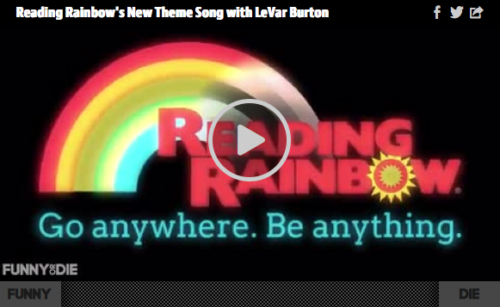
Thanks to Jules for the link!
Our Kickstarter video of the day (since we always have at least one per Video Sunday these days) is a good one. Remember the Slate article that came out earlier this year called “This Is What a Librarian Looks Like”? Well the fellow behind the piece wants to go to ALA and do something with a huge swath of librarians. And for a modest sum of $3,000 too. Granted he’s already doubled his goal, but no reason why he shouldn’t triple it, eh?

Oh my! A hat tip as well as a big thank you to Travis Jonker for locating this video of author/illustrator John Hendrix. As a big time fan of his work, I found this a real treat.
Thanks to 100 Scope Notes for the link.
I wasn’t able to make Book Expo this year and, by extension, wasn’t able to attend the BEA Children’s Breakfast. So this Mem Fox speech at said breakfast is NOT persuading me that I wasn’t missing anything, people. Doggone it.
And for your off-topic video of the day, ain’t nothing hotter than women who make classical musical funny and incredibly difficult all at the same time. Love this stuff.

By:
Bianca Schulze,
on 4/14/2014
Blog:
The Children's Book Review
(
Login to Add to MyJacketFlap)
JacketFlap tags:
William Nicholson,
Deborah Underwood,
Salina Yoon,
Charles Santore,
Seasonal: Holiday Books,
Sarah Jones,
Bunny Books,
Margery Williams,
Best Kids Stories,
Claudia Rueda,
Ages 0-3,
Ages 4-8,
Picture Books,
Cats,
Book Lists,
Gift Books,
featured,
Golden Books,
Easter Bunny,
Rabbits,
Animal Books,
The Velveteen Rabbit,
Add a tag
Move over doggy and kitty books (unless you're a book about a cat that wants to be a bunny), adorable bunny books are in abundance and multiplying all of the time. Whether you're looking for an Easter basket filler, a simply sweet tale or something classic like The Velveteen Rabbit, we've got you covered—and twice on the "Velveteen" front.
 A real post that has nothing to do with videos on a Sunday? Am I out of my friggin’ gourd? Maybe so, but today is a special occasion. You see, today, I am pleased to announce that I wrote something . . . on another person’s blog. Admittedly I don’t usually do that sort of thing but when Angie Karcher met me at an SCBWI Regional Conference in Indiana last November (my very first keynote!) she convinced me that this was a cool idea.
A real post that has nothing to do with videos on a Sunday? Am I out of my friggin’ gourd? Maybe so, but today is a special occasion. You see, today, I am pleased to announce that I wrote something . . . on another person’s blog. Admittedly I don’t usually do that sort of thing but when Angie Karcher met me at an SCBWI Regional Conference in Indiana last November (my very first keynote!) she convinced me that this was a cool idea.
You see Angie’s been running a Rhyming Picture Book Month series over at her blog and she has some pretty darn big names involved. Just take a look at the calendar and you can see a lot of familiar faces, as well as some newbies. When she asked me to contribute something I was initially stumped. Then an idea hit. I have read a LOT of picture books in 2014. Why don’t I just sift through them and find the rhyming picture book I liked best?
Easier said than done. For all their charms, good rhyming picture books are near impossible to do. At their worst they sound like Dr. Seuss in a blender. At their best they shine like bright jewels in a sea of morass. Fortunately, there is one book out in 2014 that struck me as particularly smart and beautiful. None other than Deborah Underwood’s Bad Bye / Good Bye.
So I don’t interview folks very often, but Deborah was a doll. Head on over to Angie’s site where I sit Ms. Underwood down (in the proverbial sense) and ask her the ins and outs of how one goes about writing something that rhymes while telling a complete story at the same time. Then, when you’re done with that, take a trip to Seven Impossible Things Before Breakfast where Jules interviews artist Jonathan Bean and shows some truly cool behind-the-scenes sketches of the book in question. Fun stuff for a pretty Sunday.

By:
Bianca Schulze,
on 3/19/2014
Blog:
The Children's Book Review
(
Login to Add to MyJacketFlap)
JacketFlap tags:
Humor,
Illustrator Interviews,
Author Interviews,
Easter,
Easter Bunny,
Animal Books,
Easter Eggs,
Deborah Underwood,
Seasonal: Holiday Books,
Claudia Rueda,
Interview,
Ages 0-3,
Ages 4-8,
Picture Books,
Cats,
Add a tag
It's rare that an author and illustrator get to work closely together while creating a picture book—this makes it very fun to get a peek into a conversation between a picture book duo that have been paired together by an editor and live in two different countries. In the case of the adorable Here Comes the Easter Cat, bestselling author Deborah Underwood wanted to know how award-winning illustrator Claudia Rueda managed to capture both Cat's crankiness and his sweetness.
By:
Bianca Schulze,
on 12/6/2012
Blog:
The Children's Book Review
(
Login to Add to MyJacketFlap)
JacketFlap tags:
Ages 0-3,
Ages 4-8,
Picture Books,
Christmas,
Book Lists,
Geraldine McCaughrean,
Jane Yolen,
featured,
Kristina Swarner,
Mark Teague,
Renata Liwska,
Deborah Underwood,
Dan Andreasen,
Seasonal: Holiday Books,
Joy N. Hulme,
Kirsten Hall,
Simon Mendez,
Add a tag
By Bianca Schulze, The Children’s Book Review
Published: December 6, 2012
By Deborah Underwood; Illustrated by Renata Liwska
Reading level: Ages 4 and up
Hardcover: 32 pages
Publisher: Houghton Mifflin Books for Children (October 16, 2012)
It’s impossible to keep quiet any longer. It just has to be shouted loudly to everyone: We love the winning combination of Deborah Underwood’s sweet and pitch-perfect “quiet” holiday moments and Renata Liwska’s gentle and charming drawings that make you wish you could reach into the pages and give each and every character a warm embrace. Make a little book bundle and include the original The Quiet Book and The Loud Book—three books and a piece of ribbon and you have the perfect gift for any young child—go the extra mile and tie a little stuffy on top, too.
By Jane Yolen; Illustrated by Mark teague
Reading level: Ages 0-4
Hardcover: 40 pages
Publisher: The Blue Sky Press (September 1, 2012)
Get ready to roar with laughter with your preschooler. The bestselling combo Jane Yolen and Mark Teague are back again with their winning “How Do Dinosaurs” series. The oversized, egocentric, juvenile dinosaurs wreak havoc through the house for the first half of the picture book—they have no regard for the special traditions of Christmas. As per usual, good behavior is highlighted in the second half and a lesson of “how not to act” is delivered brilliantly. This is a must-have Christmas book, especially for fans of prehistoric animals.
By Kirsten Hall; Illustrated by Simon Mendez
Reading level: Ages 4 and up
Hardcover: 20 pages
Publisher: Sterling Children’s Books (October 2, 2012)
With lyrical verses that have a nostalgic quality and a unique art form that allows every painted illustration to change with a simple pull of a tab, this is a Christmas book that will hold an audience captivated.
By Geraldine McCaughrean; Illustrated by Kristina Swarner
Reading level: Ages 2-7
Hardcover: 24 pages
Publisher: Chronicle Books (October 3, 2012)
We can’t resist the magical movement of this new take on The Nutcracker. Large die-cut board pages have been made to be handled and allow the cast of characters to literally dance there way through the story. This Nutcracker version gets our vote based on the delightful illustrations and inventive paper-engineering—”A Magic Theatre Book” is definitely the write description.
By Joy N. Hulme; Illustrated by Dan Andreasen
Reading level: Ages 1-3
Board book: 22 pages
Publisher: Sterling Children’s Books; Brdbk edition (October 1, 2012)
Not just a numbers primer for babies and toddlers, the stunning artwork of Dan Andreasen and Joy N. Hulme’s gentle rhymes also introduce the littlest readers to the religious beginnings of Christmas.
Looking for more suggestions? Try our lists from previous years:
20 of the Best Kids Christmas Books
Christmas Board Books for Babies and Toddlers
Original article: Christmas Books: Five of the Best New Gift Books for Christmas
©2012 The Childrens Book Review. All Rights Reserved.
The Christmas Quiet Book,
by Deborah Underwood, illustrated by Renata Liwska, Houghton Mifflin, $12.99, ages 4 and up, 32 pages, 2012. Animals with fur like felted wool soak up the quiet moments of the holiday, in this adorable companion to the national bestsellers
The Quiet Book and
The Loud Book!. On the snowy days leading up to Christmas, bunnies, bears, a mole, a hedgehog, an owl and an iguana share intimate moments when nothing is said out loud but everything is understood. They experience the quiet wonder of hanging a star on the top of a Christmas tree and making angels in the snow, and the cozy silence of being so bundled up in winter gear that they look as if they'll have to wobble around. They feel the chilly quiet of knocking on a friend's burrow with mittens, and the warm silence of sipping hot cocoa as they snuggle their paws. They share the quiet concentration of decorating a gingerbread house and the awkward silence when two friends meet under mistletoe. And together they own an embarrassing moment; when one friend forgets a line during a Christmas pageant, another saves him with a friendly whisper. Underwood's simple, spare words sparkle with humor and caring, while Liwska's animals are so soft and cuddly looking, it's hard not to reach out and try to pet them.
Best part: An illustration labeled "Reading by the fire quiet." A bunny falls asleep on her tummy while reading, and as she dreams, tiny animal drawings parade off the pages into the shadows. (If you like this book, be sure to read Liwska's
Little Panda.)

By:
Tara,
on 11/29/2011
Blog:
Tara Lazar
(
Login to Add to MyJacketFlap)
JacketFlap tags:
Deborah Underwood,
The Quiet Book,
The Loud Book,
A Balloon for Isabel,
PiBoIdMo 2011,
Granny Gomez & Jigsaw,
Part-Time Princess,
Pirate Mom,
Sugar Plum Ballerina,
The Christmas Quiet Book,
Picture Books,
Add a tag
 by Deborah Underwood
by Deborah Underwood
It’s the end of the month. Hooray! And congratulations!
If you’re brilliant, you have thirty picture book ideas, all of which can be transformed into stunning manuscripts. If this is you, stop reading here; take the rest of the day off.
If you’re like me, however, you have thirty sparks. Thirty scraggly shoots. Thirty teensy brown-paper-wrapped parcels of hope.
Now it’s time to test them for viability.
Here’s the image that always comes to my mind during this part of the process: I’m in a dentist’s chair. The dentist pokes and scrapes at a suspicious tooth, gently at first, then harder, then really hard. I silently pray, “Please don’t find anything wrong. Please. Ohpleaseohpleaseohplease.”
My ideas are my babies. I love them. But my ultimate goal is to get manuscripts out into the world. If an idea isn’t strong enough, better to let it go than to spend the next month banging my head against my desk.
So here are some suggestions as you begin your deliberations:
1) Check for competition.
If my idea hinges on a distinctive title, I Google and hope the title doesn’t turn up elsewhere. If it centers on an unusual animal or situation, I go to Amazon.com or Books in Print and search for similar books. If it’s a hook-y concept, and I can’t remember if I’ve seen it before, I ask around (a good children’s librarian can be your best friend for this type of thing).
 2) Make sure the plot—or the concept, for concept books—is strong.
2) Make sure the plot—or the concept, for concept books—is strong.
Sometimes I turn an idea over and over in my mind and come to the sad realization that it’s just not different or special enough. Out it goes. But if you have a great character drowning in a mediocre idea, toss him a life preserver; maybe you can find him another home.
3) Think about marketability.
We all know the picture book market is tough. If I have a choice between developing a high-concept story or a clever but obscure idea that will require a book with expensive flaps, pull tabs, and a triangular fuchsia mirror, I’m going to go with the former.
4) Don’t think about marketability.
Ha—fooled you! It’s good to be aware of trends.And if an editor says she’s looking for a book about platypuses, and you happen to have one (or think you can write one), you’d be silly not to give it a shot.
But.
If you have a potentially hard-to-market idea that you really, truly love, an idea that floods you with energy and fills you with joy, here’s my advice, courtesy of Admiral Farragut: Damn the torpedoes, full speed ahead.
We simply cannot allow our creativity to be controlled by conventional wisdom. I know everyone’s saying picture books need to be—what is it now, less than seven words long? Maybe it’s six this week.
You know what? I’d bet good money that in the next year or two, some brilliant, 2,000-word picture book will take the publishing world by storm. It will be a bestseller. It will be adored by both critics and kids. And it will exist because some writer had the courage of her convictions, and because some editor was gutsy enough to take a chance on it.
I adore Press Here by Hervé Tullet
One of America's most treasured children's book authors is celebrating her 95th birthday tomorrow: Happy Birthday, Beverly Cleary! In addition to being her birthday, April 12 is also
National Drop Everything and Read Day (D.E.A.R). D.E.A.R Day is about encouraging families to make a commitment to reading together on a regular basis. Ramona Quimby became the spokesperson for the program after it was featured in
Ramona Quimby, Age 8, which is why it is celebrated on Beverly Cleary's birthday
. All you have to do to participate is drop everything and read for 30 minutes of your day. (Well okay, if you twist my arm. . . )
The New Your Times has a great profile on Beverly Cleary. I love this bit from the article:
What ultimately drove her to write for children, she recalled, was a book she noticed when she had a job in a children’s bookstore in the 1940s. In it, a puppy said: “Bow-wow. I like the green grass.”
“No dog I had ever known could talk like that,” Cleary said. She wondered once again, as she frequently had while working as a children’s librarian, “What was the matter with authors?”
Dan Santat, illustrator extraordinaire (
who allowed us into his studio for Creative Spaces last summer), has come up with a really cool idea that simultaneously helps promote his new book AND supports his local independent bookstore. For his graphic novel
Sidekicks, publishing this summer by Arthur A. Levine Books, he is offering a Limited Edition set if you purchase through his website by June 1. Included in the set is a signed hardcover copy of the book, a mystery unpublished art print, and
The Domesticated Four, a downloadable PDF that features 60 pages detailing the evolution of this graphic novel. Sounds pretty cool right? And the way all this will support an independent bookstore is that Dan will be buying the books himself from his local indie bookstore. Really, it sounds like a win/win/win scenario to me: the bookstore gets business from customers outside their normal circle (for example me, who lives in Colorado and would not normally be shopping in a Los Angeles independent bookstore), Dan gets a strengthened relationship with his local indie, and you and I get to support both artist and indie while receiving cool extra features we couldn't otherwise get. If you'd like to learn more,
go here to read more about Dan's rationale in coming up with this idea or if you're already on board
go here to buy the Limited Edition Sidekicks set.
By:
Bianca Schulze,
on 4/1/2011
Blog:
The Children's Book Review
(
Login to Add to MyJacketFlap)
JacketFlap tags:
Book Lists: Specialty picks,
Peter Lerangis,
Jude Watson,
Lauren Kate,
Victoria Kann,
Deborah Underwood,
Lincoln Peirce,
Simon Beecroft,
Ally Condie,
Pittacus Lore,
Clare Vanderpool,
Sarah Blakley-Cartwright,
Phillip C. Stead,
Kristi Yamaguchi,
Neil Gaiman,
Stephenie Meyer,
Alex Flinn,
James Patterson,
Barack Obama,
Rick Riordan,
Markus Zusak,
Jeff Kinney,
Best Sellers,
Gordon Korman,
Suzanne Collins,
Joan Holub,
John Flanagan,
Ages Four to Eight: Books for pre-school to second grade,
Ages Nine to Twelve: Books for third through sixth grade,
Teens: Books for young adults,
Add a tag
By Bianca Schulze, The Children’s Book Review
Published: April 1, 2011
Here’s the scoop on the most popular destinations on The Children’s Book Review site, the most coveted new releases and bestsellers.
THE HOT SPOTS: THE TRENDS
Kids’ Earth Day Books: Green with Environmental Awareness
The 39 Clues Blog Tour: Access Granted, Peter Lerangis
How Picture Books Play a Role in a Child’s Development
Review: Scat by Carl Hiaasen
Where to Find Free eBooks for Children Online
THE NEW RELEASES
The most coveted books that release this month:
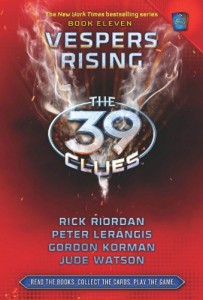
The 39 Clues, Book 11: Vespers Rising
by Rick Riordan, Peter Lerangis, Gordon Korman, Jude Watson
(Ages 8-12)
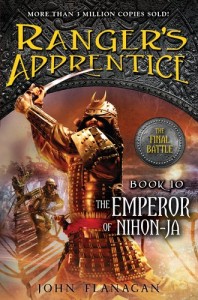 Ranger’s Apprentice, Book 10: The Emperor of Nihon-ja
Ranger’s Apprentice, Book 10: The Emperor of Nihon-ja
by John Flanagan
(Ages 9-12)
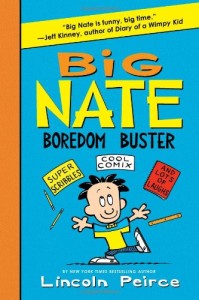 Big Nate Boredom Buster: Super Scribbles, Cool Comix, and Lots of Laughs
Big Nate Boredom Buster: Super Scribbles, Cool Comix, and Lots of Laughs
by Lincoln Peirce
(Ages 8-12)
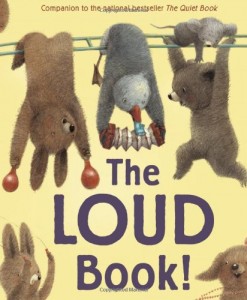 The Loud Book!
The Loud Book!
by Deborah Underwood
(Ages 1-6)
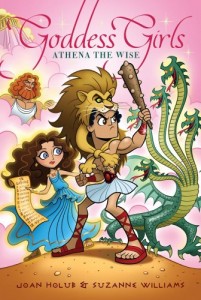 Athena the Wise (Goddess Girls)
Athena the Wise (Goddess Girls)
by Joan Holub
(Ages 8-12)
THE BEST SELLERS
The best selling children’s books this month:
PICTURE BOOKS
![]()
By Bianca Schulze, The Children’s Book Review
Published: April 1, 2011

Bestselling author Deborah Underwood
Deborah Underwood is the New York Times bestselling author of The Quiet Book, The Loud Book, A Balloon for Isabel and Granny Gomez and Jigsaw. She lives in San Francisco, California.
TCBR: Your first three picture books were released in 2010: A Balloon for Isabel, Granny Gomez and Jigsaw and The Quiet Book. How did it come about that they all released in the same fantastic year?
Deborah Underwood: I sold Granny in 2003, and Isabel and The Quiet Book in 2008—all to different publishing houses—so it was just a strange publishing quirk that they came out during a two-month period last year. What’s more, I initially wrote Isabel in 2004, but it was one of those books that just took a long time to gel. It sat in my virtual drawer for a few years before I pulled it out again and got it into marketable shape. It was great to see all those projects finally come to fruition.
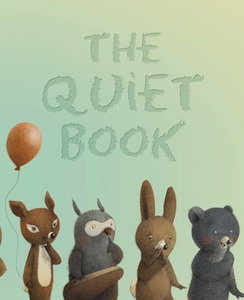 I can only imagine! Word is that it’s hard to get a book published that is considered “too quiet.” Was this book your hardest sell? And, this being the case is it satisfying to know that The Quiet Book is a New York Times bestseller?
I can only imagine! Word is that it’s hard to get a book published that is considered “too quiet.” Was this book your hardest sell? And, this being the case is it satisfying to know that The Quiet Book is a New York Times bestseller?
It certainly wasn’t an easy sell. You’re absolutely right about publishers shying away from “quiet” books; in fact, “too quiet” is a common rejection-letter line. I’m grateful that my editor saw the potential in the manuscript and was willing to go against the prevailing non-quiet trend. And yes, given that quiet books are hard to sell, the success of The Quiet Book is extra-sweet. I hope it helps open the door for other writers who want to write quiet picture books.
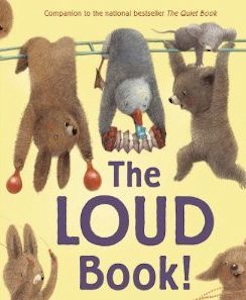 It makes sense that The Loud Book should follow closely behind its predecessor. Were you surprised at how quickly it came to fruition?
It makes sense that The Loud Book should follow closely behind its predecessor. Were you surprised at how quickly it came to fruition?
We actually started working on The Loud Book well before The Quiet Book came out. I was rewriting the text during the summer of 2009. I feel fortunate that the folks at Houghton Mifflin had enough faith in The Quiet Book to sign a sequel before it was released.
Bravo to Houghton Mifflin for having such gre
View Next 4 Posts

























 You know that feeling that you’ve missed something? Well, I had that feeling last week when I pulled out the titles for my class’s mock Caldecott. I blithely grabbed Bad Bye, Good Bye and thought, “Uh-oh. I never wrote about this one, did I?” In true Robin Smith fashion (ask any of my editors what a procrastinator I am), here I am, just under the wire, to chat about this fine book.
You know that feeling that you’ve missed something? Well, I had that feeling last week when I pulled out the titles for my class’s mock Caldecott. I blithely grabbed Bad Bye, Good Bye and thought, “Uh-oh. I never wrote about this one, did I?” In true Robin Smith fashion (ask any of my editors what a procrastinator I am), here I am, just under the wire, to chat about this fine book. by
by 














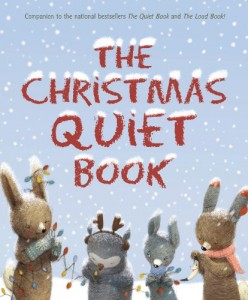
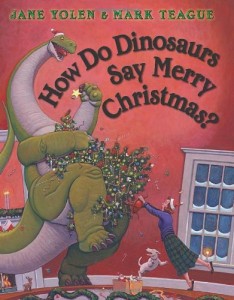

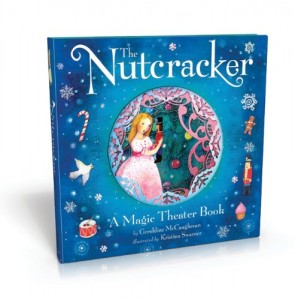
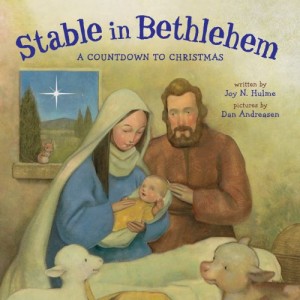
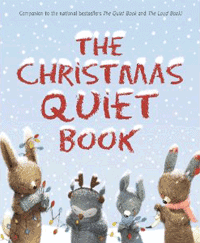
 by
by  2) Make sure the plot—or the concept, for concept books—is strong.
2) Make sure the plot—or the concept, for concept books—is strong.









I can’t wait for this one. Super cute cover too!
My kids (and I) will love this. We want it … now!
Hurray for you! Can’t wait to read it.
Congrats!
Looks great! Congrats.
This looks terrific. Congrats, Betsy!
So excited!
Now please go make 10 more.
kthxbai 😉
Pre-ordered. Way to go!
What a great idea. Thanks for editing such a terrific selection.
Wow! This looks terrific! Congratulations!
YES! I want one, too! Heading over to pre-order… whoosh.
I will be adding this to my collection. We really need some funny, as we Canadians peer over the border, nervously watching our American neighbo(u)rs go to the polls.
This book looks and sounds amazing. I cannot wait to read it and share it with my students.
Love the idea! Love the cover! Love the line-up of authors! HATE the pub. date! ;-(
Yep, I’ll pre-order it now.
Congratulations to all!
I’m laughing already! Congratulations, Betsy! -Feelin’ free and will order
AWESOME cover, and heartiest mazel tovs!!!!! cannot WAIT to read. (i just typed “cannot wait to rad.” i am sure it is that.)
Considering all the latest “developments,” can you please, please move up the publication date? (I can solicit Pigeon’s help on pleading, if it’ll help.)
I like the way you think.
Awesome sauce! Can’t wait to read this.
Congratulations, Betsy! Looks delightful!